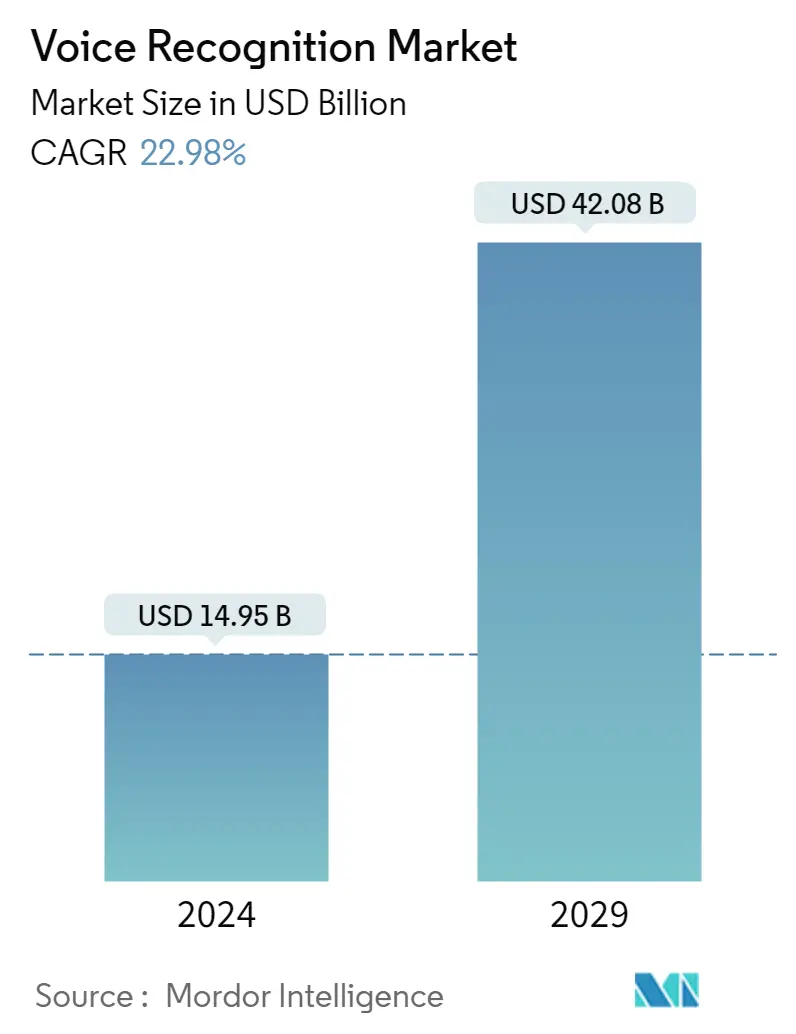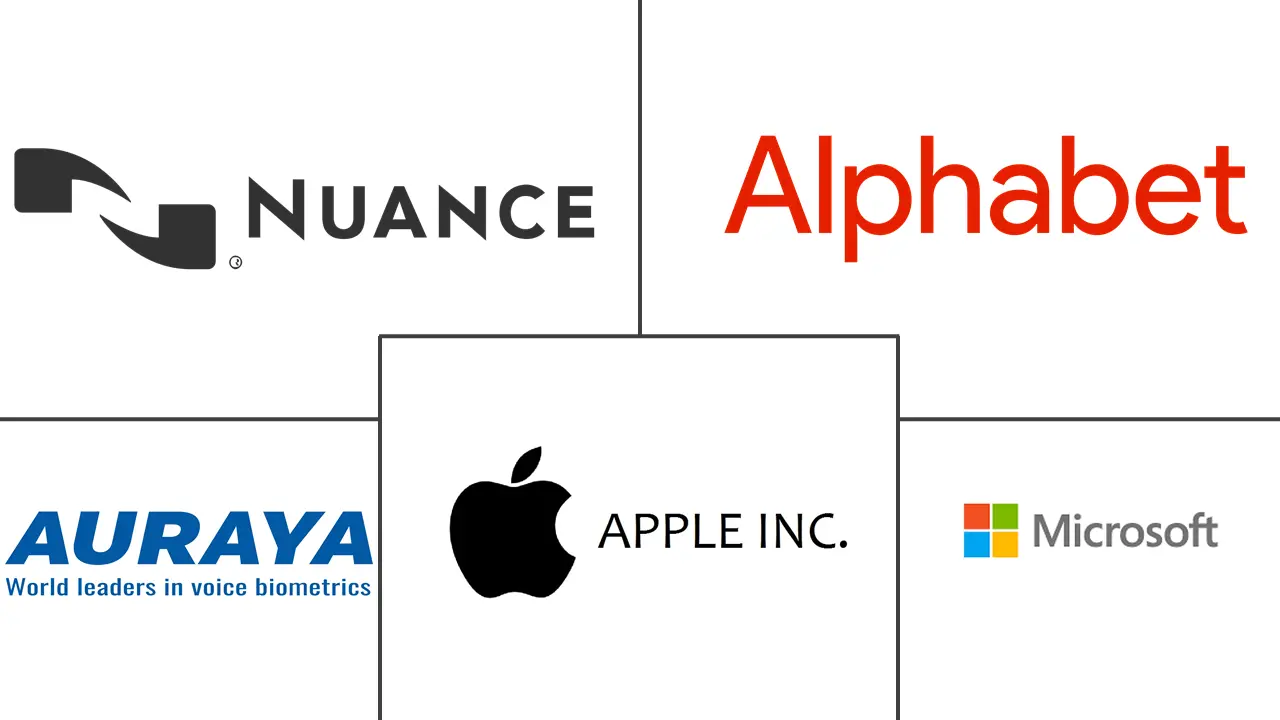Market Size of Voice Recognition Industry

| Study Period | 2019 - 2029 |
| Market Size (2024) | USD 14.95 Billion |
| Market Size (2029) | USD 42.08 Billion |
| CAGR (2024 - 2029) | 22.98 % |
| Fastest Growing Market | Asia Pacific |
| Largest Market | North America |
Major Players
*Disclaimer: Major Players sorted in no particular order |
Voice Recognition Market Analysis
The Voice Recognition Market size is estimated at USD 14.95 billion in 2024, and is expected to reach USD 42.08 billion by 2029, growing at a CAGR of 22.98% during the forecast period (2024-2029).
Increasing demand for voice-activated systems, voice-enabled virtual assistant systems, and voice-enabled devices, owing to the rising applications in retail, banking, connected devices, smart homes, healthcare, and automobile sectors, is driving the market growth.
- Adopting speech recognition software in cell phones allows doctors and therapists to convert their speech into a rich, thorough clinical statement stored in the Electronic Health Record (EHR) platform. Over the forecast period, the industry is likely to be driven by the rising adoption of voice-enabled connected systems in smart home automation. IoT gadgets enhance a variety of typically offline equipment by providing creative user interfaces and standard methods, including touch displays and buttons.
- The growing use of voice identification with speech intelligence in numerous industrial sectors drives global demand. Several players are merging innovations with speech identification techniques to make it simpler for enterprises to implement systems that augment their interaction centers with an AI-based digital workplace. For instance, in June 2022, ArkX Laboratories unveiled the release of EveryWord Voice Control, which incorporates the Sensory TrulyHandsfree SDK software stack. When combined with the manufacturing-ready EveryWord Audio Front End (AFE) or Voice Control unit, the two businesses' innovative far-field voice acquisition and speech recognition advancements facilitate OEMs to generate tailored wake-words, small to medium-sized command sets (21 dialects), and speaker confirmation concepts for voice interfaces.
- Increasing adoption of AI and voice assistance technologies across end-user verticals, including healthcare institutions, are expected to propel the market during the forecast period. For instance, Amazon recently introduced a novel solution for hospitals that integrates speech intelligence into healthcare environments at a larger scale. The service, composed of Alexa Smart Facilities, will make it easier for hospitals and senior care institutions to install and operate Alexa-enabled equipment throughout their properties to improve healthcare services.
- The COVID-19 pandemic positively impacted the industry. With the majority of people working from home, the need for intelligent equipment and gadgets skyrocketed. This generated a potential for suppliers of audio and voice commands. Furthermore, as a method of contactless human engagement, most people embraced speech technology for finding and aiding in the entertainment, communication, and medical fields.
Voice Recognition Industry Segmentation
The capacity of a computer or software to accept and analyze speech or to recognize and follow verbal instructions is called voice recognition. With the emergence of AI and intelligent assistants, including Apple's Siri, Amazon's Alexa, and Microsoft's Cortana, voice control has increased its importance and use.
The study is Segmented by Deployment Type (Cloud, On-premise), End User (Automotive, Banking, Telecommunications, Healthcare, Government, Consumer Applications, Other End Users), and Geography (North America, Europe, Asia-Pacific, Rest of the World). The market sizes and forecasts are provided in terms of value in USD million for all the above segments.
| By Deployment | |
| Cloud | |
| On-premise |
| By End User | |
| Automotive | |
| Banking | |
| Telecommunication | |
| Healthcare | |
| Government | |
| Consumer Applications | |
| Other End Users |
| By Geography | |
| North America | |
| Europe | |
| Asia-Pacific | |
| Rest of the World |
Voice Recognition Market Size Summary
The voice recognition market is poised for significant expansion, driven by the increasing demand for voice-activated systems and devices across various sectors such as retail, banking, healthcare, and smart homes. The integration of voice-enabled virtual assistants and connected systems in smart home automation is a key factor propelling market growth. The adoption of speech recognition software in healthcare, particularly for converting speech into clinical statements within Electronic Health Records, highlights the technology's expanding application. The COVID-19 pandemic further accelerated the adoption of voice technology as a contactless interaction method, enhancing its appeal in sectors like entertainment, communication, and healthcare. The market is also witnessing innovations, such as ArkX Laboratories' EveryWord Voice Control, which combines advanced voice acquisition and recognition technologies, facilitating customized voice interfaces for OEMs.
The market landscape is becoming increasingly competitive, with major players like Nuance Communications, Microsoft, and Apple investing in product innovation to maintain their market positions. The rise of local players is intensifying competition, leading to a fragmented market. Developments in voice-assisted digital payment systems, such as Tonetag's collaboration with public sector institutions, are expected to drive further growth. The market's expansion is also supported by the growing adoption of AI and voice assistance technologies in various end-user verticals. In regions like China, the high adoption rates of voice recognition technologies are fueled by the burgeoning number of smart devices and voice engagement services. As the market continues to evolve, collaborations and technological advancements, such as those seen in the Speech Accessibility Project and Paychex Voice Assist, are set to enhance the capabilities and applications of voice recognition technology.
Voice Recognition Market Size - Table of Contents
-
1. MARKET DYNAMICS
-
1.1 Market Drivers
-
1.1.1 Growth of the Authentication Market
-
1.1.2 Increase in Voice-based Searches
-
1.1.3 Demand for Connected Devices
-
-
1.2 Market Challenges
-
1.2.1 High Cost and Accuracy-related Issues
-
-
-
2. MARKET SEGMENTATION
-
2.1 By Deployment
-
2.1.1 Cloud
-
2.1.2 On-premise
-
-
2.2 By End User
-
2.2.1 Automotive
-
2.2.2 Banking
-
2.2.3 Telecommunication
-
2.2.4 Healthcare
-
2.2.5 Government
-
2.2.6 Consumer Applications
-
2.2.7 Other End Users
-
-
2.3 By Geography
-
2.3.1 North America
-
2.3.2 Europe
-
2.3.3 Asia-Pacific
-
2.3.4 Rest of the World
-
-
Voice Recognition Market Size FAQs
How big is the Voice Recognition Market?
The Voice Recognition Market size is expected to reach USD 14.95 billion in 2024 and grow at a CAGR of 22.98% to reach USD 42.08 billion by 2029.
What is the current Voice Recognition Market size?
In 2024, the Voice Recognition Market size is expected to reach USD 14.95 billion.

